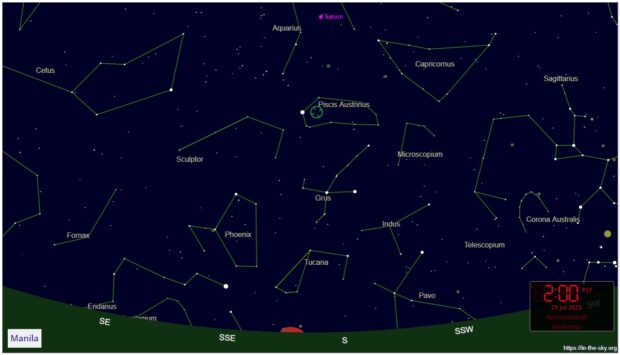
This photo shows the Philippine Atmospheric, Geophysical and Astronomical Services Administration’s forecast of the southern sky during the peak of Piscis Austrinid meteor shower event at 2 a.m. on July 29, 2023. Photo from Pagasa
-
-
PISCIS AUSTRINID METEOR SHOWER BEST SEEN BETWEEN JULY 29 AND AUGUST 10
-
FROM 8:47 P.M. UNTIL DAWN, PISCIS AUSTRINIDS WILL MAKE FIVE METEORS EVERY HOUR
-
METEORS CAN BE SEEN AT 2:00 A.M. WHEN THE RADIANT IS AT ITS HIGHEST POINT
-
IT WILL BE HARD TO SEE BECAUSE THE MOON IS GETTING BIGGER
-
MANILA, Philippines — Astronomy enthusiasts may be in for a treat later this July, with three celestial events reaching their peak showcase.
The Philippine Atmospheric, Geophysical and Astronomical Services Administration (Pagasa) said Tuesday that meteor showers are set to occur thrice this month.
According to state meteorologists, the three meteor shower events are the Piscis Austrinid, Southern Delta Aquariid, and Alpha Capricornid – all are expected to peak either July 29 or 30.
Pagasa Astronomical Observatory Chief Renato de Leon explained that “peak equates to the frequency of meteor showers.”
“The Piscis Austrinid meteor shower will be active from July 15 to August 10, with peak activity occurring on July 29,” Pagasa said in its latest astronomical diary.
It added that the Piscis Austrinid meteor shower is classified as a “minor meteor shower,” producing around five meteors per hour which will be best viewed under moonless and dark sky conditions.
The Southern Delta Aquariid and Alpha Capricornid meteor showers, meanwhile, will peak on July 30, Pagasa also said.
“[The] Southern Delta Aquariids will be active from July 12 to August 23 [while] the Alpha Capricornids will be active from July 3 to August 5,” it noted.
Apart from having the exact peak of activity, the Southern Delta Aquariid and Alpha Capricornid meteor shower events may be witnessed in the southeastern sky and are likely to produce their best displays at around 2 a.m., according to Pagasa.
The Southern Delta Aquariid, Pagasa said, is expected to produce 25 meteors per hour, while the Alpha Capricornid may produce at least five meteors per hour.
Meteor showers are visible through the naked eye, even without gears like telescopes and binoculars.
RELATED STORIES
Meteor showers visible in late July
Gaze up: June Bootid meteor shower peaking on June 27
Thursday mid-day celestial spectacle: Partial solar eclipse